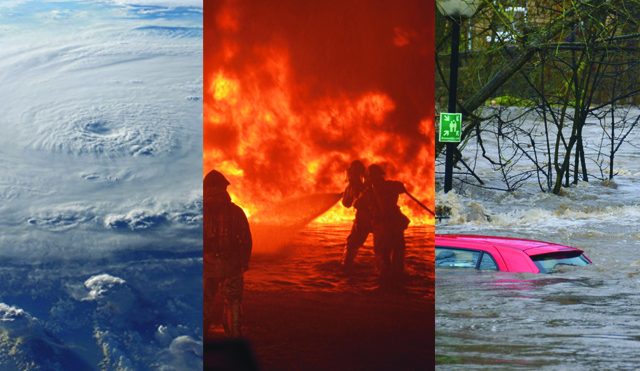Each year, we are seeing increasing levels of unprecedented climate disaster. Our hearts go out to all of the communities impacted by hurricanes, wildfires, and floods. How are each of these caused by climate change, and what can we do to reverse these conditions?
Hurricanes
When fossil fuels like coal, oil, and natural gas are burned, they release greenhouse gases (GHGs) like carbon dioxide (CO2) into the atmosphere. These gasses trap heat, causing an increase in ocean temperature and global warming. Hurricanes are fueled by warmer oceans, which increases their power and may increase their destructive potential.
Recent catastrophes: Hurricanes Harvey and Maria in 2017 demonstrated the devastation caused by strong storms, including flooding and infrastructure destruction. This year, Hurricane Hilary hit the western coast of North America, causing millions of dollars of damage. This particular hurricane caused the National Hurricane Center to issue its “first ever tropical storm watch for parts of Southern California” (NOAA).
Solution: By reducing our dependence on fossil fuels, renewable energy reduces GHGs, which helps prevent the frequency and severity of hurricanes. The IEA estimates approximately 75% of global emissions come from the energy sector. Solar panels do not release any greenhouse gasses when generating electricity because they utilize the sun’s energy to generate power. Switching to renewables slows the warming of the oceans and diminishes heat-trapping gasses in the atmosphere.
Wildfires
Ecosystem imbalances caused by climate change are increasing the spread of invasive species. For example, spruce beetles are traveling northwards at a rapid rate into territories where native species have not had time to develop defenses. Additionally, the poles of the earth are warming at 4 times the rate as the rest of the planet (Nature Journal), making boreal forests much more susceptible to wildfires. Rising atmospheric temperatures create protracted droughts that create circumstances for wildfires to spread quickly, burn hotter, and become more destructive.
Recent disasters: The California wildfires in 2020 burned millions of acres and left extensive damage. Canada has been ravaged by wildfire this summer, with 59,000 square miles of damage. The fires covered vast parts of North America in smoke (NPR).
Solution: Indigenous forest stewardship with managed cultural burns (a practice that was outlawed by colonizers) is important for clearing ladder fuel with low temperature, controlled fires that do not spread to more mature trees. First Nations have cultivated nature-based solutions for tens of thousands of years. Following indigenous leadership and re-indigenizing our relationship with our ecosystem is crucial for reversing climate change and preventing forest fires.
Floods
Sea levels are rising due to global temperatures increasing, which causes glaciers to melt and seawater molecules to expand (NOAA). The use of fossil fuels raises global temperatures, which in turn causes heavier and more unpredictable rainfall. When an area does not receive rain for an extended period of time, the ground becomes hard, and when a year’s worth of rain falls all at once, it washes away as opposed to being absorbed into the water table. All of this increases the likelihood of flooding.
Recent catastrophe: The vulnerability of many locations to rising waters has been highlighted by recent flooding catastrophes like floods in 2021 in Germany and Belgium as well as the recurrent coastal flooding in cities like Miami and Venice. Heavy rains in Spain and New York have also caused a series of flash floods this Fall. These are only a few of many locations around the world that are impacted by rising water and floods.
Another Recent catastrophe: Over 27 people lost their lives and 50 were injured as a result of severe floods that were caused by heavy rains in Yaoundé, the capital of Cameroon. Buildings were destroyed by the floods, which also left considerable damage. Authorities are still looking for missing people among the wreckage as rescue operations are ongoing.
Solution: By transitioning our energy systems away from fossil fuels and lowering carbon emissions, renewable energy can help combat floods. Solar energy has a low impact on the environment, creates shade, and can be coupled with agroforestry. Distributed renewable energy microgrids can slow the rate of sea-level rise, help create clean drinking water, and create resilience in impacted communities.
As we are witnessing, climate change is accelerating the frequency and severity of disasters, and those who are hardest hit are frontline communities who are already vulnerable. These times call for resilience through local and global community building and immediate, unprecedented climate action for a just transition. We can restore a healthy climate together by following frontline leadership, adopting renewable technology, demanding that corporations and politicians support climate justice, and banking with financial institutions that are divested from fossil fuels.
Photo credits: Pixabay, Chris Gallagher

